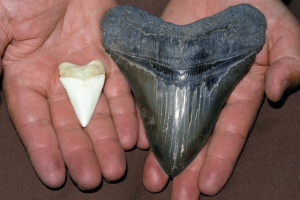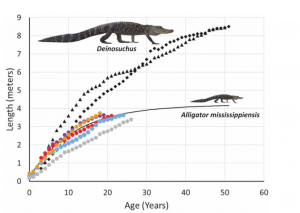Long-lived Organisms in the Past
The book of Genesis in the Bible tells of pre-Flood patriarchs living for several centuries. In addition, we note that the age of sexual maturity (when these patriarchs were fathering their firstborn sons) in Genesis 5 was typically over 100 years! Whatever factors were resulting in slower maturation and extreme human longevity in the pre-Flood world were likely also affecting the animal kingdom.
Paleontologists have known for many years that fossilized organisms grew larger, as a rule, than their modern counterparts. But it is more difficult to ascertain how long fossilized organisms lived in the ancient past. Indeed, a given fossil may not yet have attained its maximum age at the time of the catastrophe that fossilized it. Also, the fossil that we happened to find might not have been the biggest and longest-lived specimen of that ancient population. But increasingly new tools are becoming available to help us ascertain the lifespan of organisms from the distant past. Even if we can’t establish how old a given animal was, we can sometimes determine when they reached maturity. If a population of organisms are reaching maturity at a much older age than a comparable variety is today, it is reasonable to expect that they would also have a longer lifespan. Indeed studies of living organisms have shown a correlation between larger adult body size, longevity, and greater ages at maturity. (Lee, W.-S., et al., “Experimental Demonstration of the Growth Rate-lifespan Trade-off,” Proceedings of the Royal Society: 280, 2013, p. 1–8.)
 Let’s consider a few examples. Hebert notes, “Paleontologists have used allometric relationships and growth rings within shark vertebrae to construct ontogenetic length-versus-age growth curves for both extinct and extant sharks. Growth curves for fossil sharks are generally too short to provide direct evidence that fossil sharks experienced much greater longevity than extant sharks, but they are sufficiently long to show that fossil sharks took longer to mature than comparable extant sharks.” (Hebert, Jake, “Giantism and Delayed Maturation in Fossil Sharks: Evidence for Extreme Longevity?,” CRSQ, 2024 vol. 60, pp. 267–283.)
Let’s consider a few examples. Hebert notes, “Paleontologists have used allometric relationships and growth rings within shark vertebrae to construct ontogenetic length-versus-age growth curves for both extinct and extant sharks. Growth curves for fossil sharks are generally too short to provide direct evidence that fossil sharks experienced much greater longevity than extant sharks, but they are sufficiently long to show that fossil sharks took longer to mature than comparable extant sharks.” (Hebert, Jake, “Giantism and Delayed Maturation in Fossil Sharks: Evidence for Extreme Longevity?,” CRSQ, 2024 vol. 60, pp. 267–283.)
 The field of skeletochronology is making it possible to gain insight into the growth trajectories of giant fossilized crocodilian monsters such as Deinosuchus and Sarcosuchus. Their growth curves indicate that these crocodilians grew for at least 60 years before reaching maturity. This growth burst alone is significantly greater than the total 30-year lifespan of living crocodilians. “Given the evidence from longevity studies linking both larger adult body sizes and greater ages at maturation to greater longevity, the large adult body sizes of Deinosuchus and Sarcosuchus and their prolonged maturation intervals are indirect evidence of lifespans greater than extant crocodilians. Other giant fossil crocodilians, some of which may be direct ancestors of extant crocodilians, were also likely experiencing greater longevity.” (Hebert, Jake, “Fossil Crocodilians Grew Larger and Longer, and Lived Longer than Extant Crocodilians,” CRSQ 61, 2025, pp. 172–188.)
The field of skeletochronology is making it possible to gain insight into the growth trajectories of giant fossilized crocodilian monsters such as Deinosuchus and Sarcosuchus. Their growth curves indicate that these crocodilians grew for at least 60 years before reaching maturity. This growth burst alone is significantly greater than the total 30-year lifespan of living crocodilians. “Given the evidence from longevity studies linking both larger adult body sizes and greater ages at maturation to greater longevity, the large adult body sizes of Deinosuchus and Sarcosuchus and their prolonged maturation intervals are indirect evidence of lifespans greater than extant crocodilians. Other giant fossil crocodilians, some of which may be direct ancestors of extant crocodilians, were also likely experiencing greater longevity.” (Hebert, Jake, “Fossil Crocodilians Grew Larger and Longer, and Lived Longer than Extant Crocodilians,” CRSQ 61, 2025, pp. 172–188.)
 It seems that some small mammals whose fossils are in Jurassic layers were experiencing delayed maturation and longer life as well. Ontogenetic growth curves have provided direct evidence of extreme longevity in early mouse or shrew-like animals. “Unlike today’s small mammals, early mammals grew much more slowly but had significantly longer lifespans, living eight to fourteen years instead of the one or two years typical of modern small mammals like mice. However, early mammals also took much longer to reach sexual maturity, often requiring several years, compared to the few months needed by their modern counterparts.” (Ionescu, Andrei, “Early Mammals had Slower Growth Rates and Lived Longer,” Earth.com, 8/12/2024.)
It seems that some small mammals whose fossils are in Jurassic layers were experiencing delayed maturation and longer life as well. Ontogenetic growth curves have provided direct evidence of extreme longevity in early mouse or shrew-like animals. “Unlike today’s small mammals, early mammals grew much more slowly but had significantly longer lifespans, living eight to fourteen years instead of the one or two years typical of modern small mammals like mice. However, early mammals also took much longer to reach sexual maturity, often requiring several years, compared to the few months needed by their modern counterparts.” (Ionescu, Andrei, “Early Mammals had Slower Growth Rates and Lived Longer,” Earth.com, 8/12/2024.)
There is even evidence for greater longevity in fossil bivalves from Japan and the Gulf of Aqaba, as well as in Antarctic bivalve and ammonite fossils. (Hebert, Jake, “Evidence for Greater Pre- and Immediate Post-Flood Animal Longevity,” Creation Research Soceity Conference Presentation, July 25, 2025.) This is an active area of research and more results should be available soon. Even though we have only cited a few specific examples, there is reason to have confidence that this trend of fossilized organisms living longer than modern varieties will continue to hold as more specimens are analyzed with cutting-edge methodologies. Size is a reasonably accurate proxy for age in most living species and, as we have mentioned, gigantism is widespread in the fossil record.





